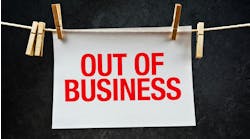When sales fell at Artistic Autobody, owner Terry Mostul knew it’d be smart to start bolstering his marketing efforts. But instead of blindly allocating money to a marketing blitz, he wanted to know he would see a good return on investment: “What good does it do if we stimulate more people to come in our door, but we don’t do the best job we possibly can in converting them to sales?” So Mostul had his front desk staff and estimators—the shop’s main contact with potential customers—undergo sales training through ContactPoint Solutions, a company that provides training and call recording to help businesses improve their closing ratios.
Artistic Autobody has three locations in the Portland, Ore., metro area and reaches $7 million in annual sales. After just a few weeks of training, Mostul has high expectations for the program. “My goal is to improve our closing ratio by 20 percent,” he says. Right now, the collision repair center’s overall closing ratio is about 65 percent. Through ContactPoint’s mentoring and monitoring of employee phone calls, Mostul expects to hit 85 percent within six months.
SELLING YOURSELF
Jeremiah Wilson, president of ContactPoint Solutions, says potential customers don’t buy your service, they buy you. “It doesn’t matter if you’re the absolute best body shop in town, they have to like you,” he says. You want your shop to be the last one the customer calls—and ensuring that is easier than you might think. The first step is to carefully listen to how you sound on the phone with prospective customers. ContactPoint training focuses heavily on call recording. “I can say, ‘When you said this, that was great!’ or “Those three things you have to get rid of,’” Wilson explains.
He says the sale occurs the moment the potential customer likes you. So how can you sound better to make that happen? Here are a few tips for ensuring that a prospective sale turns into an actual sale:
Listen well. Wilson says the biggest mistake that estimators make while meeting with a potential customer is simply tuning the person out. “They know what they want to say, and they don’t adjust to what they hear.” This may cause the estimator to miss a valuable piece of information from the customer—or it may simply cause the customer to think his or her problem doesn’t matter. “It has become mundane,” Wilson says of estimators working with customers each day. “It’s not fresh or new.” Spending time listening to what the customer is saying instead of just handing over the estimate will go a long way toward ensuring you close the sale.
Mind your tone. During call recording, Wilson pays special attention to tone. Even if you’re not naturally upbeat on the phone, you have to try to be. “All too often, we’ll hear someone say, ‘That’s just who I am,’” he says. “Absolutely I’ll say, ‘Get out of this business.’ You have to sound like someone they want to talk to. If you have to sit there and smile in a mirror, do it.” Sounds extreme, but a prospective customer can interpret your tone—and consequently, your interest in talking with them—very quickly on the phone. A surefire way to lose a sale is to sound indifferent or uncaring.
Make it personal. “You have to use their name,” Wilson says. “When you use their name, you get their attention.” He says studies have shown that the synapses in a person’s brain fire during different thought processes, and when you say certain words—such as the person’s name—the person you’re talking to becomes more engaged.
Be empathetic. It’s easy to lack sensitivity to a prospective customer’s plight. “Ultimately, [employees] don’t really care about the customer,” Wilson says. “That’s the hardest one for people to embrace, and you can hear that through the phone. I’ve [listened] to hundreds of calls in the past month … and there’s not true empathy. They’re just desensitized.” Overcome that, Wilson says, by “treating that customer as if they were your own mother.”
Commit to change. While these steps are simple, you have to want to change to make the changes successful. “Put it out there [and say], ‘I want it,’” Wilson says. “Figure out why you’re not [closing sales].” Whether it’s a personal problem or just a bad day, figure out why you’re not as warm or caring as you’d like to be with prospective customers and then commit to changing that about yourself.
—Jeremiah Wilson, president, ContactPoint Solutions
SHOP SUCCESS
Mostul says sales coaching has helped his employees realize the importance of actually asking for the sale from a prospective customer. “We’ve essentially been order-takers like the cashier at McDonald’s. We’ve got to get back to the basics and consider ourselves sales people. By working to do a better job than anyone else to fit their needs, we can close that sale.”
Though Mostul’s employees were initially less than thrilled about having their calls recorded, they’re learning a lot. “It’s a powerful thing,” he says. “Customers can tell whether you’re on top of your game. Everyone has bad moments; we just practice how to hide that. The call recording is great with that.”
It’s also been a helpful way for employees to learn how to address different situations on the phone. “Training teaches you, regardless of the question asked, how to answer it,” Mostul says. “They can think ahead now. It gives them a lot more confidence and results in a more comfortable-sounding conversation.” For example, if a customer asks if the shop offers free loaner cars, instead of simply saying no, the employee can respond with, “We don’t, but we would be happy to set you up with a rental car.”
Ken Franczek, general manager of Crystal Glass in Edmonton, Alberta, says the ContactPoint training program has helped the company’s customer service representatives sharpen their sales skills. The business, which has more than 50 locations throughout Canada, repairs and replaces auto glass, windshields, and residential and commercial glass. Franczek says the results of sales coaching were immediate. “In the first three months of the program, we saw a significant increase in the bottom line on a per-order basis,” he says. “An order we might have sold for $199 [is now sold for] 20 to 25 percent more.” He credits this increase to the sales staff learning how to explain Crystal Glass’s value to prospective customers. Customers now understand why it’s worthwhile to pay a little more. “If you don’t explain those things to the customers, you’re just the same as the guy next door,” Franczek says. “There’s no reason to pay a little more for a ‘little better’ if you don’t know what that ‘little better’ is.”
CONTINUOUS LEARNING
Wilson says the results of sales coaching come quickly. “When your people are liked, you’re going to get an immediate increase in your closing ratio. Then, there are the residual effects, like long-term customers and referrals for new business.”
For Mostul, the investment has been worth it so far. “It’s not cheap, I will tell you that, but I’m comfortable with the value. The accountability is what’s huge about this thing. You don’t lose sight of where you’ve been. Once [employees] get comfortable with it, they’re going to do such a better job, and that has a significant impact on business.”



